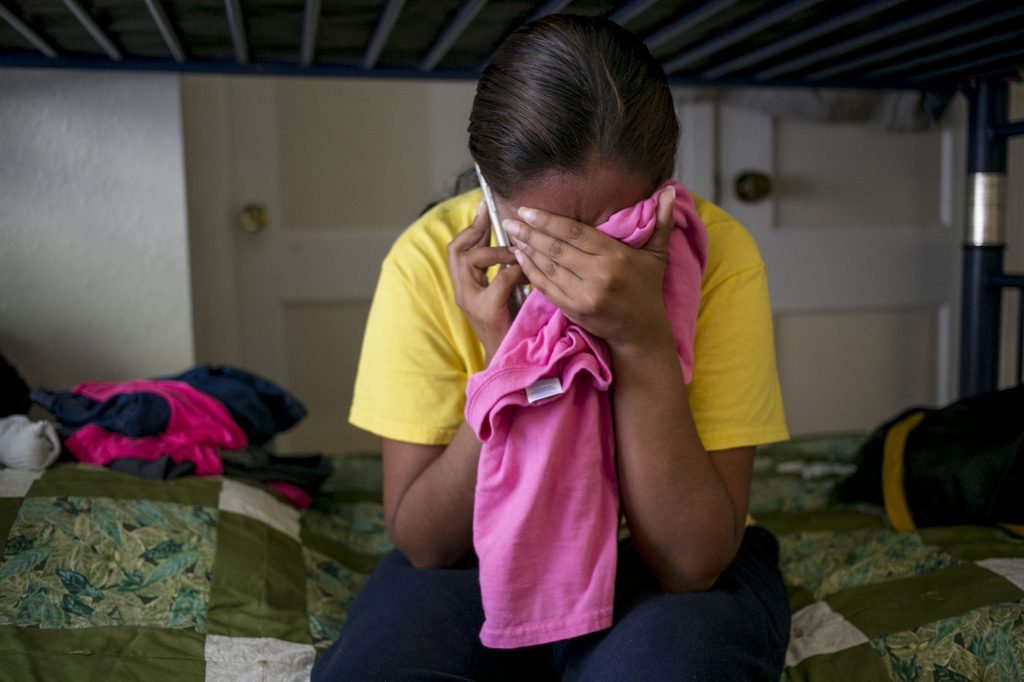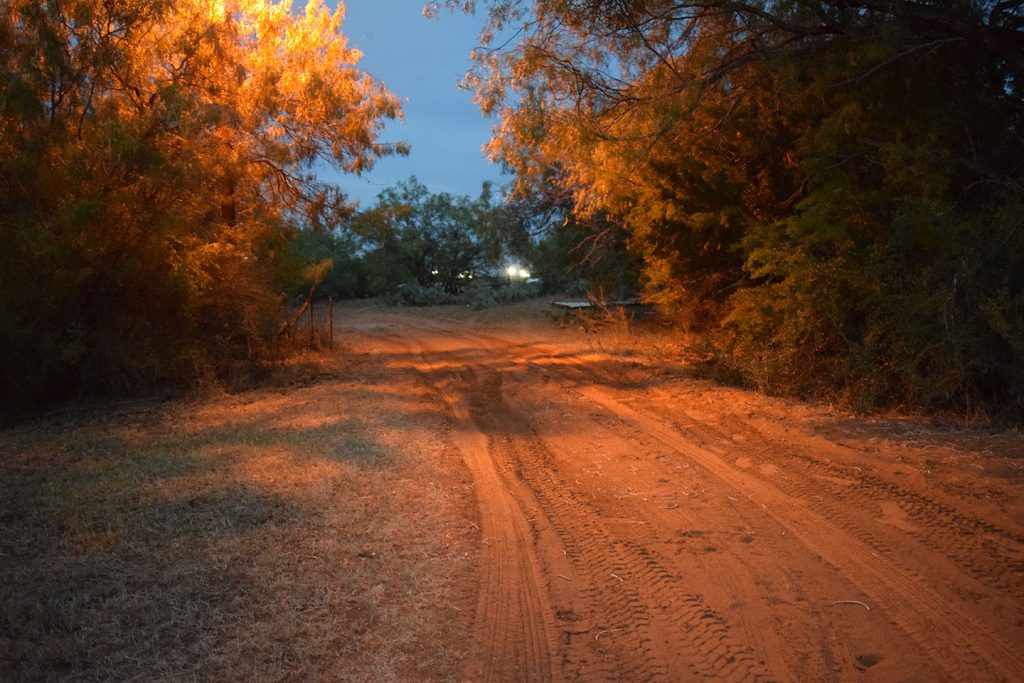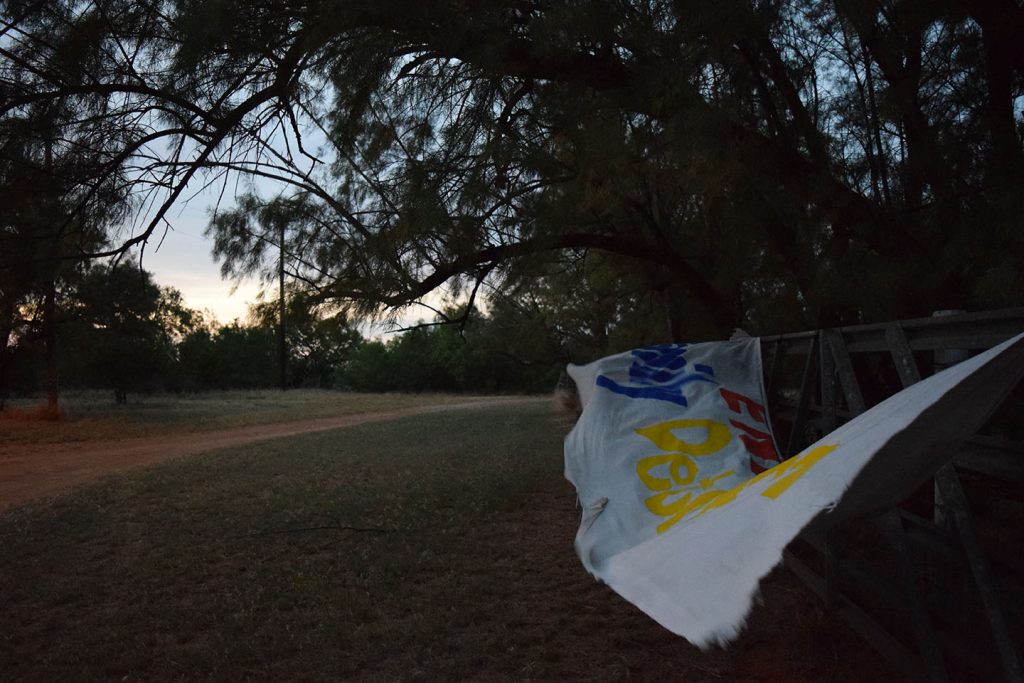The Trauma of Helping Asylum-Seekers

“Did I ever tell you about the time I punched a wall?” Jay asks with an embarrassed laugh.
Jay (a pseudonym) was working as a legal advocate at a so-called family detention center in the small rural town of Dilley, Texas, when I first met him. The privately run South Texas Family Residential Center (STFRC) opened in late 2014 in response to an increase of mothers and children, mostly from Central America, seeking asylum in the U.S. Some of these asylum-seeking women who cross the Mexico-U.S. border with their children of minor age are involuntarily incarcerated in the facility while their cases go through an initial legal review.
Detainees and their children arrive at the center confused, having been improperly informed of the cause and function of their detention, and often traumatized. Inside facilities like the STFRC, administrators and the staff add to the detainees’ trauma in various ways, from offering inadequate medical services to verbally abusing them. The poor conditions at such facilities have been noted by the many advocates who have witnessed and reported on them, and have inspired numerous lawsuits, only some of which have effected limited positive change.
What is less well-known is that life for the aid workers who toil alongside detainees is also traumatic. And their work is incredibly stressful. These circumstances are what led Jay, after one particularly frustrating day in 2015, to smash his fist into a concrete wall.
Neither the administrators of the STFRC nor the U.S. federal government hires lawyers or legal advocates to assist detainees with their asylum cases; the sole function of the facility is to incarcerate immigrant mothers and children. Since this center’s opening, legal advocates and various nonprofits have fought for access to detainees in order to provide them with legal aid. Today, a handful of on-site staff are supported by rafts of volunteers who flow through the center, often for only a week’s time. In any given week, there can be three, a dozen, or 20 such people helping the detainees. These legal advocates spend up to 12 hours a day in an overly air-conditioned mobile trailer meeting with their clients, often listening to harrowing tales of why immigrants fled their home countries.
Life for on-site legal aid staff like Jay can be particularly challenging. Unlike the weekly volunteers, most of the staff live near the facility and have few opportunities to escape from their work for the duration of their tenure, which can range from months to a year. Their lives are frequently consumed by the needs of their jobs, which are both physically and emotionally taxing.
From 2016 to 2017, I spent a year working as one of these volunteers, while also studying, as an anthropologist, what life is like for legal advocates in these facilities. Throughout my time at the center, I came to realize, as many legal advocates do, how poorly detainees are treated by immigration officials and the legal system, and how inspiring, caring, and resilient the incarcerated mothers and children are in the face of that. I also saw how compassionate and tenacious many legal advocates are, and how they suffer as a result of these same injustices.
The story of how Jay came to punch a wall begins with a Guatemalan mother he met earlier on the day of the incident. In learning about her case, he discovered that she had arrived at the Mexico-U.S. border with her two daughters, asking for asylum, but she was sent to the detention center in Dilley with only her younger daughter. Her elder daughter, who was over 18 years old, was sent to an adult detention facility elsewhere, as only children of minor age are kept with their parents at the STFRC. (The separation of various family members, not just parents from their children, has been and continues to be a tragically common occurrence.)
The mother’s native tongue is Mam (a Mayan language), not Spanish, so the staff of the facility had a hard time finding an interpreter; as a result of this, at the time, her case was processed more slowly than others. Jay didn’t know how long she had been separated from her daughter by the time she finally met with his legal aid team, though it was likely at least a week. She had been given no information about the whereabouts of her child. Jay emailed an asylum officer contact to find out where she was. Within an hour, he received a curt reply: “Did not claim fear. Was removed.”
That was it. She had been deported. The email provided no explanation of how this decision was made, or if the elder daughter had been provided with a Mam interpreter so that she could fully understand the questions being posed to her—particularly the crucial one about whether or not she was afraid to return to Guatemala. Jay had to break this news to his client, who was already distraught.
When Jay saw the mother enter the building for their meeting, he grabbed a staff member and took them into one of the visitation rooms. Jay explained the situation to him and asked, “What do I do?” He was looking for advice as he struggled to think through how to tell the mother the awful news. After talking it through with his co-worker, Jay eventually realized that he just needed to sit the mother down and tell her that he was sorry, that her daughter had been deported, and that he knows the news is horrible.
“So I told her, and she started crying. And then she just started bawling, wailing even,” Jay told me. “Her 15-year-old daughter was there, and she was amazingly strong and supportive.” He moved with them into a private room so the mother could grieve without distressing other mothers who were working on their paperwork. “We went in and just kind of sat there. Then we called her son in Guatemala, and he was like, ‘Yeah, she’s on her way back [to Guatemala] today.’” Jay added, “Her daughter had been threatened with rape [prior to emigrating], and she [the mother] thought that she was going to get raped and killed, and so that … it just took a lot out of me.”
This happened a little before 8 p.m., at the end of a long work day and at the close of a stressful work week. After the woman and her daughter left, Jay went back to the staff residence across the field from the facility, he recalls. In the evenings, the facility’s floodlights obscure the typically clear and star-filled Texas sky; visible from the staff residence, they are a constant reminder of the critical work needing to be done and the lives that are depending on the aid workers.
That evening, Jay and his co-workers drank and listened to music in their living room. As he put it, they tried to “forget about stuff.” Then a song came on the radio that reminded Jay of a terrible past relationship that had ended horribly.
“I just flipped,” he remembers. “I went into the bathroom to just like be alone. I felt like everything just came together, and I punched the wall.”
The conditions at Dilley and the stresses of the job often come as a shock to the well-meaning staff and volunteers who wind up there. Incoming staff and volunteers undergo training sessions and orientations before they arrive, but many repeatedly told me that a person can’t truly comprehend the situation and its demands until they see the place, hear the stories, and actually spend time at the facility.
In Jay’s own words, working as a legal advocate in family detention can make you feel like you’re going crazy. The work can be disheartening and exhausting—fighting a steep, uphill battle against immigration authorities, asylum officers, and the privatized prison industry, all while trying to offer gentle care to women and children speaking about old traumas even as they experience new ones. And then there’s the constant uncertainty: Much of what immigration or asylum authorities choose to do or not do seems unpredictable and arbitrary.
The advocates I met tended to diminish or delegitimize their own pain. I did this too. In comparison with the horrific things that have happened to the asylum-seekers with whom we work, our own distress seems insignificant and irrelevant. And yet the pain of doing this type of advocacy work is real: from listening to story after story of tremendous abuse, to witnessing new injustices on this side of the border, to trying to manifest comfort for those who seemingly have so little control over the actions of state authorities.
This sort of pain can have real consequences for advocates. Some I spoke with after they left this work reported having nightmares about the facility, sometimes involving not getting work done on a client’s behalf or even reliving a client’s story. Some would have unexpected outbursts of crying, triggered by a stranger’s face that reminded them of a client or a flashback of a moment at the facility. After only a brief period of being there, this started to happen to me as well. And while efforts have been made to help advocates cope with the secondary trauma produced by their work, the very nature of the job makes it an inevitable and formidable force. Unfortunately, as is the case with much nonprofit work, there are too few resources to simultaneously fight against these many injustices while also shielding workers from vicarious trauma.
So why do people do it? The advocates I met often responded to this question incredulously, as if it was the most obvious thing in the world: How could they not? There’s a need, and the detention of immigrant women and children is wrong, so they helped. But this doesn’t entirely reflect what I witnessed while at the facility. There is another reason why these advocates come back to this dusty little blip of a town about 100 miles from the border: an unmatched, almost addictive pleasure from the work.
They seem to feel this from seeing the positive effects of legal advocacy. Aid workers’ actions range from the simple to the complex: from finding an appropriate interpreter to communicate the qualifications for asylum ahead of one’s asylum interview, to advocating for early release for clients who require serious medical care, to submitting 11th-hour documentation in order to shield a client from swift deportation.
Advocates also feel a sense of solidarity by working with like-minded colleagues—deep bonds are formed quite quickly in this intense and challenging environment. The experience “of Dilley,” as many advocates simply say, is one characterized by dramatic levels of both emotion and pressure.
The women and children detained at the South Texas Family Residential Center, and those who advocate for them, each have their own past traumas and fresh pain. Sometimes another person’s experiences and emotions can feel indistinguishable from your own. Sometimes it all collides against a concrete block on a warm evening in Texas.
While he didn’t break his hand, Jay couldn’t properly use it for two weeks after that night. This made some everyday aspects of the job—like typing up emails to asylum officials—challenging. But in the moment before his fist met that block of concrete, he just couldn’t help it, he said. “It would happen every once in a while,” he told me, “that feeling of really, really deep anger. It would enrage, if that’s even the right word.” Yet the very nature of the work made him fall in love, he added.
Each week while I was at the facility, the staff held two evening meetings with the volunteers. During these meetings, we would often share stories, cry, complain about guards, and laugh about something funny a child did or said. One evening, a tall and fiercely impressive immigration lawyer who had volunteered with the project many times before sat on the couch with a Corona in her hand, looking exasperated. “I’m just so fucking upset that this place still exists,” she said. “That we haven’t found a way to bring it all down. … It makes me so mad.”
None who have worked as a legal advocate in Dilley would disagree. Yet an equally extraordinary, young staff attorney for the project said something that still sticks with me: “True. But it’s nice to be mad together.”




































